Structure
In Tasmania, dry sclerophyll forests are dominated by Eucalyptus species, with 25 of the 29 Eucalypt species endemic to Tasmania growing in these communities. These trees form a dominant layer but unlike the great heights reached by Eucalyptus regnans in wet sclerophyll and mixed forests, the dryer conditions restrict the height of eucalypts to no more than 30 metres. [2]
Poor nutrient availability in the soil and low rainfall in these areas make it difficult for most species to survive. The large, dominant Eucalypts grow far less dense than in wet sclerophyll forests, increasing the light availability to understory plants and shrubs. This high sunlight is too severe for most species and restricts growth. Few understory plants are found in these communities and are usually restricted to drought-tolerant acacia species and the native cherry (Exocarpus cupressiformis). There are often many grasses (and bracken) in these forests and a sparse hard-leafed shrub layer. Groundcover is often restricted to leaf litter and rocks with patches of sandy soil visible.
The increase in light availability allows the Eucalypts to have greater floristic diversity than found in wet sclerophyll forests. [4]
Growth rates of all plants in dry sclerophyll forests are slow and as water is the limiting factor in these environments, energy for growth is often directed to the roots and lignotubers.

Eucalyptus is a genus of over seven hundred species of flowering trees, shrubs or mallees in the myrtle family, Myrtaceae. Along with several other genera in the tribe Eucalypteae, including Corymbia, they are commonly known as eucalypts. Plants in the genus Eucalyptus have bark that is either smooth, fibrous, hard or stringy, leaves with oil glands, and sepals and petals that are fused to form a "cap" or operculum over the stamens. The fruit is a woody capsule commonly referred to as a "gumnut".
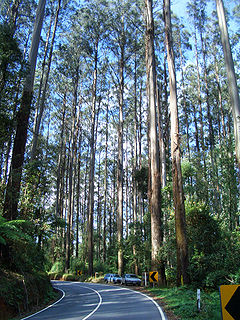
Eucalyptus regnans, known variously as mountain ash, swamp gum, or stringy gum, is a species of medium-sized to very tall forest tree that is native to the Australia states of Tasmania and Victoria. It is a straight-trunked tree with smooth grey bark, but with a stocking of rough brown bark at the base, glossy green, lance-shaped to curved adult leaves, flower buds in groups of between nine and fifteen, white flowers and cup-shaped or conical fruit. It is the tallest of all flowering plants; the tallest measured living specimen, named Centurion, stands 100.5 metres tall in Tasmania.

Sclerophyll is a type of vegetation that is adapted to long periods of dryness and heat. The plants feature hard leaves, short internodes and leaf orientation which is parallel or oblique to direct sunlight. The word comes from the Greek sklēros (hard) and phyllon (leaf). The term was coined by A.F.W. Schimper in 1898, originally as a synonym of xeromorph, but the two words were later differentiated.

Acacia aneura, commonly known as mulga or true mulga, is a shrub or small tree native to arid outback areas of Australia. It is the dominant tree in the habitat to which it gives its name (mulga) that occurs across much of inland Australia. Specific regions have been designated the Western Australian mulga shrublands in Western Australia and Mulga Lands in Queensland.

The Madagascar subhumid forests are a tropical moist broadleaf forest ecoregion that covers most of the Central Highlands of the island of Madagascar. They are included in the WWF's Global 200 list of outstanding ecoregions. Most of the original habitats have been lost due to human pressure.

Exocarpos cupressiformis, with common names that include native cherry, cherry ballart, and cypress cherry, belongs to the sandalwood family of plants. It is a species endemic to Australia. Occasionally the genus name is spelt "Exocarpus" but it appears to be mostly no longer in use.

The Victoria Plains tropical savanna is a tropical and subtropical grasslands, savannas, and shrublands ecoregion in northwestern Australia.

Eucalyptus pulchella, commonly known as the white peppermint or narrow-leaved peppermint, is a species of small to medium-sized tree that is endemic to Tasmania. it has smooth bark, sometimes with rough fibrous bark on older trees, linear leaves, flower buds in groups of nine to twenty or more, white flowers and cup-shaped to shortened spherical fruit.
Tasmania can be broadly divided into two distinct regions, eastern and western, that exhibit major differences in climate, geology and vegetation. This divide, termed Tyler’s Corridor, runs from just south of the northwestern corner, and continues south, cutting roughly down the center of the island. The vegetation changes occur principally due to variations in soil types, which are a result of the geological composition, and the vast difference in climate across the state. Generally, the west has a higher mean rainfall but poor acidic soil while the east has a lower mean rainfall but slightly more fertile soil. This results in a larger proportion of rainforest, moorland and wet sclerophyll vegetation dominating in the west and predominantly dry sclerophyll in the east.
The relationships between fire, vegetation, and climate create what is known as a fire regime. Within a fire regime, fire ecologists study the relationship between diverse ecosystems and fire; not only how fire affects vegetation, but also how vegetation affects the behavior of fire. The study of neighboring vegetation types that may be highly flammable and less flammable has provided insight into how these vegetation types can exist side by side, and are maintained by the presence or absence of fire events. Ecologists have studied these boundaries between different vegetation types, such as a closed canopy forest and a grassland, and hypothesized about how climate and soil fertility create these boundaries in vegetation types. Research in the field of pyrogeography shows how fire also plays an important role in the maintenance of dominant vegetation types, and how different vegetation types with distinct relationships to fire can exist side by side in the same climate conditions. These relationships can be described in conceptual models called fire–vegetation feedbacks, and alternative stable states.

The Cumberland Plain Woodland, or Western Sydney woodland, is a grassy woodland community found predominantly in Western Sydney, New South Wales, Australia, that comprises an open tree canopy, a groundcover with grasses and herbs, usually with layers of shrubs and/or small trees.

The ecology of Sydney, located in the state of New South Wales, Australia, is diverse for its size, where it would mainly feature biomes such as grassy woodlands and some sclerophyll forests, with a few pockets of mallee shrublands, subtropical and temperate rainforests (evergreen), heathlands, and wetlands. The combination of climate, topography, moisture, and soil influence the dispersion of these ecological communities across a height gradient from 0 to 200 metres. There are many hiking trails, paved and unpaved roads for exploring the many different biomes and ecosystems.
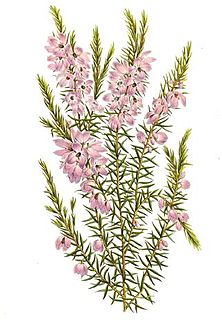
Tetratheca pilosa is a flowering plant in the family Elaeocarpaceae, endemic to Australia. It is a small shrub found in dry sclerophyll forests, open heathlands and woodlands of Australia. It was first recorded in 1805 by French botanist Jacques Labillardière.
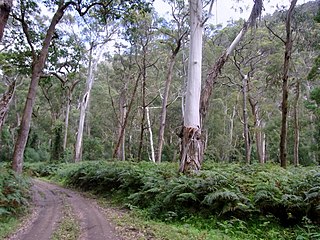
The Southeast Australia temperate forests is a temperate broadleaf and mixed forests ecoregion of south-eastern Australia. It includes the temperate lowland forests of southeastern Australia, at the southern end of the Great Dividing Range. Vegetation ranges from wet forests along the coast to dry forests and woodlands inland.
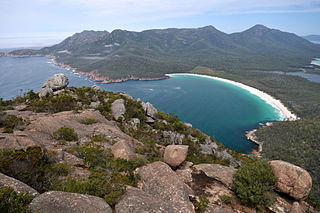
The Tasmanian temperate forests is a temperate broadleaf and mixed forests ecoregion in Australia. The ecoregion occupies the eastern portion of the island of Tasmania, which lies south of the Australian mainland.

The Tasmanian Central Highland forests is a temperate broadleaf and mixed forests ecoregion in Australia. It covers Tasmania's Central Highlands region.

Bedfordia salicina, commonly known as Tasmanian blanketleaf, is an endemic angiosperm of Tasmania, Australia. It is widespread throughout wet sclerophyll forests, moist gullies and intermediate forests and woodlands between wet and dry sclerophyll communities. Bedfordia salicina is abundant at low elevations, on dolerite, sandstone and mudstone substrate, east of Tylers line. Alternating leaves droop down to blanket the stem, coining the species common name, blanketleaf.

The Blue Mountains and Southern Highlands Basalt Forests are a sclerophyll temperate forest community that stretch from the northern fringes of the Blue Mountains to the Southern Highlands. Featuring both wet and dry sclerophyll forests, as well as small rainforest pockets, the community features tall (30m+) and open eucalypt forests and woodlands that lie on igneous rock.
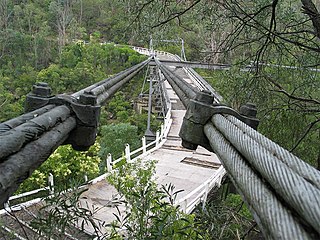
The Western Sydney Dry Rainforest and Moist Woodland is a dry rainforest found in small pockets in south-western Sydney, New South Wales, Australia. Mostly featuring sclerophyll vegetation, it is listed as critically endangered under Australia's national environment law, the Environment Protection and Biodiversity Conservation Act 1999 as more than 70 per cent of its original extent has been reduced as a result of clearing, logging, weed invasion and heavy grazing.




















